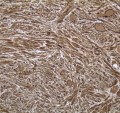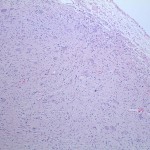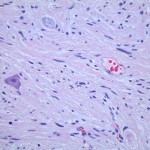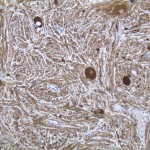Bladder Mass

CLINICAL HISTORY
A 34-year old woman presents with a bladder mass.
PHOTOMICROGRAPHS:
Quiz-summary
0 of 3 questions completed
Questions:
- 1
- 2
- 3
Information
Begin Quiz
You have already completed the quiz before. Hence you can not start it again.
Quiz is loading...
You must sign in or sign up to start the quiz.
You have to finish following quiz, to start this quiz:
Results
0 of 3 questions answered correctly
Your time:
Time has elapsed
You have reached 0 of 0 points, (0)
| Average score |
|
| Your score |
|
Categories
- Not categorized 0%
-
Click ‘View questions’ for the discussion.
- 1
- 2
- 3
- Answered
- Review
-
Question 1 of 3
1. Question
What is your diagnosis?
CorrectGanglioneuromas are rare tumors of neural crest origin. They may be primary or may develop after maturation of a more primitive lesion, like neuroblastomas. They are found along the sympathetic nerve chain, the most common sites being posterior mediastinum, retroperitoneum, adrenal gland and neck in descending order.
IncorrectCORRECT ANSWER: D
Ganglioneuromas are rare tumors of neural crest origin. They may be primary or may develop after maturation of a more primitive lesion, like neuroblastomas. They are found along the sympathetic nerve chain, the most common sites being posterior mediastinum, retroperitoneum, adrenal gland and neck in descending order.
-
Question 2 of 3
2. Question
What is the most common location for these tumors?
CorrectGanglioneuromas are rare tumors of neural crest origin. They may be primary or may develop after maturation of a more primitive lesion, like neuroblastomas. They are found along the sympathetic nerve chain, the most common sites being posterior mediastinum, retroperitoneum, adrenal gland and neck in descending order.
IncorrectCORRECT ANSWER: D
Ganglioneuromas are rare tumors of neural crest origin. They may be primary or may develop after maturation of a more primitive lesion, like neuroblastomas. They are found along the sympathetic nerve chain, the most common sites being posterior mediastinum, retroperitoneum, adrenal gland and neck in descending order.
-
Question 3 of 3
3. Question
If you could only choose one immunohistochemical stain to establish the diagnosis which one would you use?
CorrectThe tumor consists of mature ganglion cells and schwann cells with collagen. Mitoses are very rare. It is a benign and slow growing lesion. The tumor cells are positive for S100, Synaptophysin, Neuron-specific enolase. They are negative for cytokeratin, EMA, CD117.
IncorrectCORRECT ANSWER: A
The tumor consists of mature ganglion cells and schwann cells with collagen. Mitoses are very rare. It is a benign and slow growing lesion. The tumor cells are positive for S100, Synaptophysin, Neuron-specific enolase. They are negative for cytokeratin, EMA, CD117.
Presented by : Dr. Vaidehi Avadhani and Dr. Cary Johnson.





